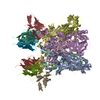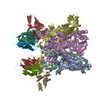+ データを開く
データを開く
- 基本情報
基本情報
| 登録情報 | データベース: PDB / ID: 3j8w | ||||||
|---|---|---|---|---|---|---|---|
| タイトル | Cryo-EM reconstruction of quasi-HPV16 complex with H263.A2 Fab | ||||||
 要素 要素 |
| ||||||
 キーワード キーワード | VIRUS/IMMUNE SYSTEM / L1 pentamer / quasi-HPV16 / L1 capsomer / Rosie online / VIRUS-IMMUNE SYSTEM complex | ||||||
| 機能・相同性 |  機能・相同性情報 機能・相同性情報T=7 icosahedral viral capsid / endocytosis involved in viral entry into host cell / virion attachment to host cell / host cell nucleus / structural molecule activity 類似検索 - 分子機能 | ||||||
| 生物種 |   Human papillomavirus type 16 (パピローマウイルス) Human papillomavirus type 16 (パピローマウイルス) | ||||||
| 手法 | 電子顕微鏡法 / 単粒子再構成法 / クライオ電子顕微鏡法 / 解像度: 13 Å | ||||||
 データ登録者 データ登録者 | Guan, J. / Hafenstein, S. | ||||||
 引用 引用 |  ジャーナル: Virology / 年: 2015 ジャーナル: Virology / 年: 2015タイトル: Structural comparison of four different antibodies interacting with human papillomavirus 16 and mechanisms of neutralization. 著者: Jian Guan / Stephanie M Bywaters / Sarah A Brendle / Hyunwook Lee / Robert E Ashley / Alexander M Makhov / James F Conway / Neil D Christensen / Susan Hafenstein /  要旨: Cryo-electron microscopy (cryo-EM) was used to solve the structures of human papillomavirus type 16 (HPV16) complexed with fragments of antibody (Fab) from three different neutralizing monoclonals ...Cryo-electron microscopy (cryo-EM) was used to solve the structures of human papillomavirus type 16 (HPV16) complexed with fragments of antibody (Fab) from three different neutralizing monoclonals (mAbs): H16.1A, H16.14J, and H263.A2. The structure-function analysis revealed predominantly monovalent binding of each Fab with capsid interactions that involved multiple loops from symmetry related copies of the major capsid protein. The residues identified in each Fab-virus interface map to a conformational groove on the surface of the capsomer. In addition to the known involvement of the FG and HI loops, the DE loop was also found to constitute the core of each epitope. Surprisingly, the epitope mapping also identified minor contributions by EF and BC loops. Complementary immunological assays included mAb and Fab neutralization. The specific binding characteristics of mAbs correlated with different neutralizing behaviors in pre- and post-attachment neutralization assays. | ||||||
| 履歴 |
|
- 構造の表示
構造の表示
| ムービー |
 ムービービューア ムービービューア |
|---|---|
| 構造ビューア | 分子:  Molmil Molmil Jmol/JSmol Jmol/JSmol |
- ダウンロードとリンク
ダウンロードとリンク
- ダウンロード
ダウンロード
| PDBx/mmCIF形式 |  3j8w.cif.gz 3j8w.cif.gz | 694.3 KB | 表示 |  PDBx/mmCIF形式 PDBx/mmCIF形式 |
|---|---|---|---|---|
| PDB形式 |  pdb3j8w.ent.gz pdb3j8w.ent.gz | 570.5 KB | 表示 |  PDB形式 PDB形式 |
| PDBx/mmJSON形式 |  3j8w.json.gz 3j8w.json.gz | ツリー表示 |  PDBx/mmJSON形式 PDBx/mmJSON形式 | |
| その他 |  その他のダウンロード その他のダウンロード |
-検証レポート
| 文書・要旨 |  3j8w_validation.pdf.gz 3j8w_validation.pdf.gz | 823.3 KB | 表示 |  wwPDB検証レポート wwPDB検証レポート |
|---|---|---|---|---|
| 文書・詳細版 |  3j8w_full_validation.pdf.gz 3j8w_full_validation.pdf.gz | 930.8 KB | 表示 | |
| XML形式データ |  3j8w_validation.xml.gz 3j8w_validation.xml.gz | 90.9 KB | 表示 | |
| CIF形式データ |  3j8w_validation.cif.gz 3j8w_validation.cif.gz | 134.1 KB | 表示 | |
| アーカイブディレクトリ |  https://data.pdbj.org/pub/pdb/validation_reports/j8/3j8w https://data.pdbj.org/pub/pdb/validation_reports/j8/3j8w ftp://data.pdbj.org/pub/pdb/validation_reports/j8/3j8w ftp://data.pdbj.org/pub/pdb/validation_reports/j8/3j8w | HTTPS FTP |
-関連構造データ
- リンク
リンク
- 集合体
集合体
| 登録構造単位 | 
|
|---|---|
| 1 | x 60
|
| 2 |
|
| 3 | x 5
|
| 4 | x 6
|
| 5 | 
|
| 対称性 | 点対称性: (シェーンフリース記号: I (正20面体型対称)) |
- 要素
要素
| #1: 抗体 | 分子量: 11942.283 Da / 分子数: 4 / 断片: variable domain Fab / 由来タイプ: 天然 / 由来: (天然)  #2: 抗体 | 分子量: 13113.628 Da / 分子数: 4 / 断片: variable domain Fab / 由来タイプ: 天然 / 由来: (天然)  #3: タンパク質 | 分子量: 50873.422 Da / 分子数: 5 / 断片: UNP residues 47-500 / 由来タイプ: 天然 由来: (天然)  Human papillomavirus type 16 (パピローマウイルス) Human papillomavirus type 16 (パピローマウイルス)参照: UniProt: Q4VRM0, UniProt: P03101*PLUS Has protein modification | Y | |
|---|
-実験情報
-実験
| 実験 | 手法: 電子顕微鏡法 |
|---|---|
| EM実験 | 試料の集合状態: PARTICLE / 3次元再構成法: 単粒子再構成法 |
- 試料調製
試料調製
| 構成要素 |
| ||||||||||||||||
|---|---|---|---|---|---|---|---|---|---|---|---|---|---|---|---|---|---|
| 分子量 | 値: 44.7 MDa / 実験値: NO | ||||||||||||||||
| ウイルスについての詳細 | 中空か: NO / エンベロープを持つか: NO / ホストのカテゴリ: VERTEBRATES / 単離: OTHER / タイプ: VIRION | ||||||||||||||||
| 天然宿主 | 生物種: Homo sapiens | ||||||||||||||||
| 緩衝液 | 名称: 1 M NaCl, 200 nM Tris / pH: 7.4 / 詳細: 1 M NaCl, 200 nM Tris | ||||||||||||||||
| 試料 | 濃度: 1.2 mg/ml / 包埋: NO / シャドウイング: NO / 染色: NO / 凍結: YES | ||||||||||||||||
| 試料支持 | 詳細: glow-discharged holey carbon supported grid | ||||||||||||||||
| 急速凍結 | 装置: GATAN CRYOPLUNGE 3 / 凍結剤: ETHANE / Temp: 102 K / 湿度: 90 % / 詳細: Plunged into liquid ethane (GATAN CRYOPLUNGE 3). |
- 電子顕微鏡撮影
電子顕微鏡撮影
| 顕微鏡 | モデル: JEOL 2100 / 日付: 2014年7月31日 |
|---|---|
| 電子銃 | 電子線源: LAB6 / 加速電圧: 200 kV / 照射モード: SPOT SCAN |
| 電子レンズ | モード: BRIGHT FIELD / 倍率(公称値): 40000 X / 最大 デフォーカス(公称値): 5520 nm / 最小 デフォーカス(公称値): 1490 nm / Cs: 2 mm |
| 試料ホルダ | 試料ホルダーモデル: GATAN LIQUID NITROGEN / 温度: 95 K |
| 撮影 | 電子線照射量: 15 e/Å2 フィルム・検出器のモデル: GATAN ULTRASCAN 4000 (4k x 4k) |
| 画像スキャン | デジタル画像の数: 264 |
| 放射 | プロトコル: SINGLE WAVELENGTH / 単色(M)・ラウエ(L): M / 散乱光タイプ: x-ray |
| 放射波長 | 相対比: 1 |
- 解析
解析
| EMソフトウェア |
| ||||||||||||
|---|---|---|---|---|---|---|---|---|---|---|---|---|---|
| CTF補正 | 詳細: Each particle | ||||||||||||
| 対称性 | 点対称性: I (正20面体型対称) | ||||||||||||
| 3次元再構成 | 手法: Cross-common Lines / 解像度: 13 Å / 解像度の算出法: FSC 0.5 CUT-OFF / 粒子像の数: 8908 / ピクセルサイズ(公称値): 2.86 Å / ピクセルサイズ(実測値): 2.86 Å 詳細: Semi-automatic particle selection was performed using e2boxer.py to obtain the particle coordinates, followed by particle boxing, linearization, normalization, and apodization of the images ...詳細: Semi-automatic particle selection was performed using e2boxer.py to obtain the particle coordinates, followed by particle boxing, linearization, normalization, and apodization of the images using Robem. Defocus and astigmatism values used to perform contrast transfer function (CTF) correction were assessed using Robem for the extracted particles. The icosahedrally averaged reconstruction was initiated using a random model generated with setup_rmc and reached 14 A resolution estimated at a Fourier Shell Correlation (FSC) of 0.5. For the last step of refinement, the final maps were CTF-corrected using a B factor of 200 A2. (Single particle details: The particles were selected using semi-automatic program e2boxer.py (EMAN2)) (Single particle--Applied symmetry: I) 対称性のタイプ: POINT | ||||||||||||
| 原子モデル構築 | プロトコル: RIGID BODY FIT / 空間: REAL / 詳細: REFINEMENT PROTOCOL--RIGID BODY | ||||||||||||
| 原子モデル構築 | 3D fitting-ID: 1 / Accession code: 3OAE / Initial refinement model-ID: 1 / PDB-ID: 3OAE  3oae
| ||||||||||||
| 精密化ステップ | サイクル: LAST
|
 ムービー
ムービー コントローラー
コントローラー



 UCSF Chimera
UCSF Chimera









 PDBj
PDBj




